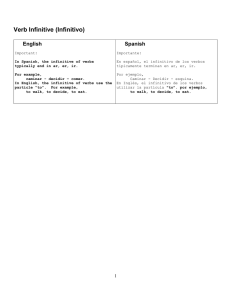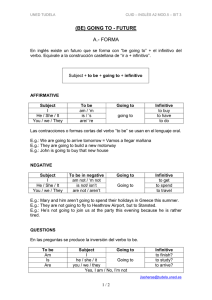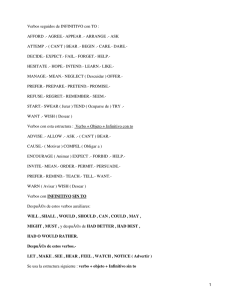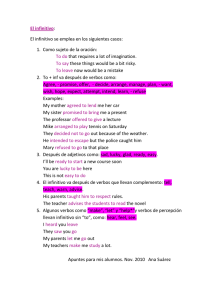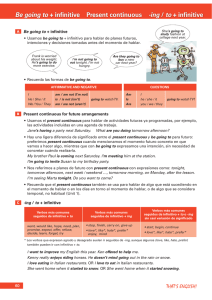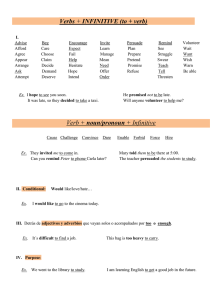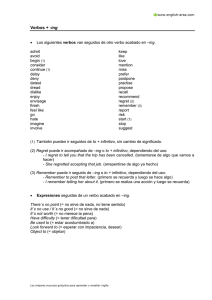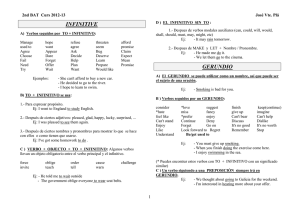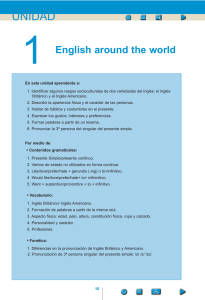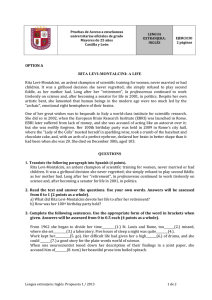Contenidos PAU Inglés Bachillerato
Anuncio
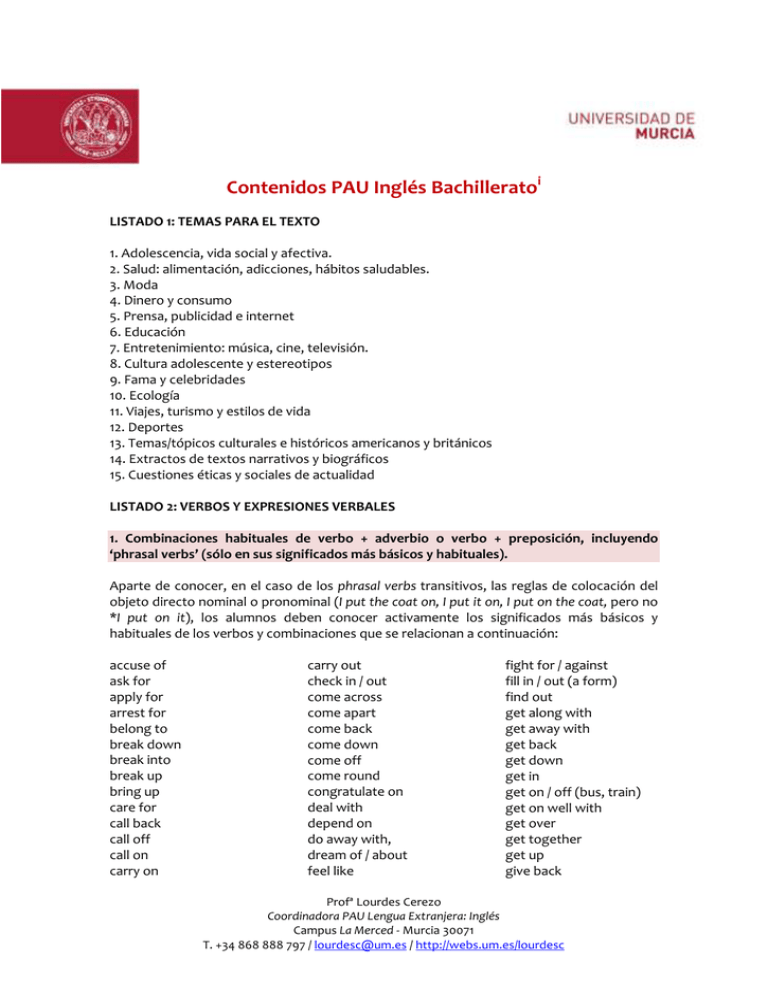
Contenidos PAU Inglés Bachilleratoi LISTADO 1: TEMAS PARA EL TEXTO 1. Adolescencia, vida social y afectiva. 2. Salud: alimentación, adicciones, hábitos saludables. 3. Moda 4. Dinero y consumo 5. Prensa, publicidad e internet 6. Educación 7. Entretenimiento: música, cine, televisión. 8. Cultura adolescente y estereotipos 9. Fama y celebridades 10. Ecología 11. Viajes, turismo y estilos de vida 12. Deportes 13. Temas/tópicos culturales e históricos americanos y británicos 14. Extractos de textos narrativos y biográficos 15. Cuestiones éticas y sociales de actualidad LISTADO 2: VERBOS Y EXPRESIONES VERBALES 1. Combinaciones habituales de verbo + adverbio o verbo + preposición, incluyendo ‘phrasal verbs’ (sólo en sus significados más básicos y habituales). Aparte de conocer, en el caso de los phrasal verbs transitivos, las reglas de colocación del objeto directo nominal o pronominal (I put the coat on, I put it on, I put on the coat, pero no *I put on it), los alumnos deben conocer activamente los significados más básicos y habituales de los verbos y combinaciones que se relacionan a continuación: accuse of ask for apply for arrest for belong to break down break into break up bring up care for call back call off call on carry on carry out check in / out come across come apart come back come down come off come round congratulate on deal with depend on do away with, dream of / about feel like fight for / against fill in / out (a form) find out get along with get away with get back get down get in get on / off (bus, train) get on well with get over get together get up give back Profª Lourdes Cerezo Coordinadora PAU Lengua Extranjera: Inglés Campus La Merced - Murcia 30071 T. +34 868 888 797 / [email protected] / http://webs.um.es/lourdesc give up go ahead go back go into go on go out go up grow up hang up hold up insist on keep away from keep on keep off laugh at leave out let down listen to look after look at look down on look for look forward to look up to (somebody) look into look like look out look up make up pay back pay for pick out pick up pull up (‘stop’) put away put down put off (‘postpone’) put on put out put up with refer to rely on retire from ring up run away from run into run out of run over set out set up sit down stand for stand out stand up switch on / off take after take apart take away take back take off take out take over take up take care of think of / about throw out try on turn back turn into turn up / down turn on / off wait for work on write down 2. Verbos que rigen infinitivo y/o -ing. 2.1. Verbos seguidos de infinitivo. a) Infinitivo con to: advise agree allow (esp. be allowed to) ask choose decide expect fail happen hesitate hope learn manage offer order prepare promise prove refuse seem swear teach tell want warn would like wish b) Infinitivo sin to: had rather / sooner, help, let, make, hear, see y otros verbos de percepción. Profª Lourdes Cerezo Coordinadora PAU Lengua Extranjera: Inglés Campus La Merced - Murcia 30071 T. +34 868 888 797 / [email protected] / http://webs.um.es/lourdesc 2.2. Verbos seguidos de –ing. avoid can’t / couldn’t help can’t / couldn’t stand consider deny detest dislike enjoy forgive keep (‘continue’) look forward to give up (don’t) mind miss pardon resist suggest understand En general, -ing detrás de verbos que indican gustos o preferencias o lo contrario. 2.3. Verbos seguidos de infinitivo o –ing: begin, cease, continue, finish, forget, go on, hate, love, like, plan, prefer, regret, remember, start, stop, try. Hay que tener en cuenta los casos en que se produce un cambio de significado del verbo principal, según vaya seguido de infinitivo o gerundio. Esta distinción no será exigible cuando sea simplemente de matiz (I like to work at home / I like working at home). 2.4. Estructuras no verbales que requieren infinitivo con to: - indefinidos: something / somewhere / anything, etc. (something to do). - ciertos adjetivos: sad, easy, difficult, etc. (difficult to see) - en interrogativas indirectas: where,how, etc. (Tell me how to do that). 2.5. Estructuras no verbales que requieren -ing: - las preposiciones: after going. - la expresión it´s no use (waiting for so long) i Nota importante: El siguiente material de referencia para las PAU en Lengua Extranjera: Inglés fue desarrollado por el anterior Coordinador, Pascual Cantos, para la prueba del curso académico20092010. Por seguir vigente en la actualidad, su contenido se reproduce en este documento de manera prácticamente integral. Profª Lourdes Cerezo Coordinadora PAU Lengua Extranjera: Inglés Campus La Merced - Murcia 30071 T. +34 868 888 797 / [email protected] / http://webs.um.es/lourdesc

